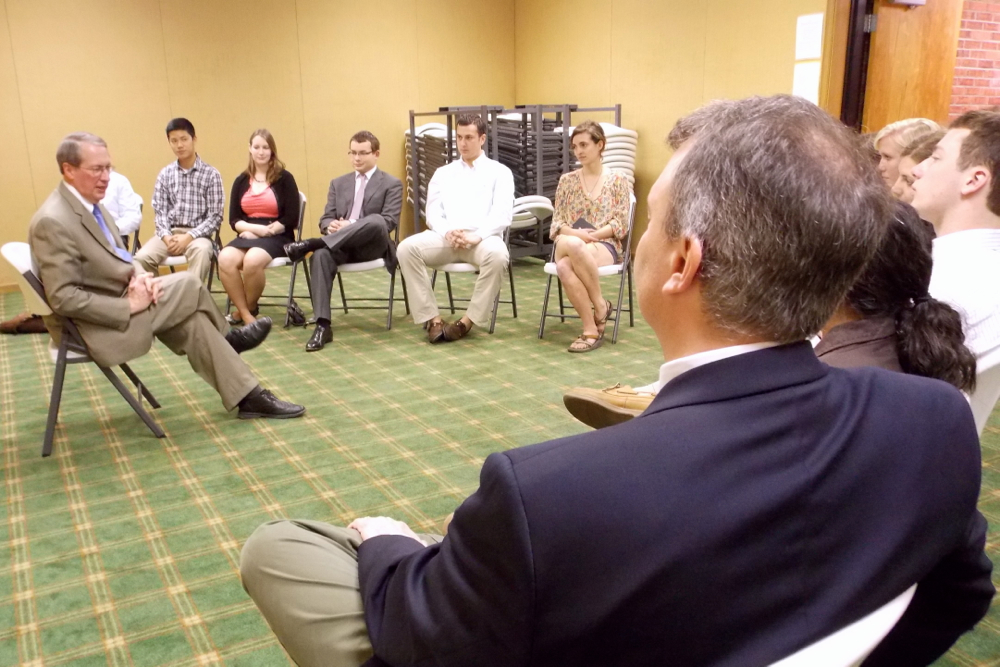After spending more than five weeks studying the current push for U.S. immigration reform, on Monday students in a University of Virginia seminar met face-to-face with one of the people at the center of crafting the new legislation: U.S. Rep. Bob Goodlatte, R-Va.
Goodlatte, who chairs the House Judiciary Committee, is the point person for House of Representatives’ legislative action on immigration reform, putting him in a small circle –along with President Obama and a handful of senators – of those who will have a hands-on role in shaping the new legislation.
Asked by one student in politics professor David Leblang’s “Global Immigration” seminar about the prospects for immigration reform in Congress, Goodlatte said he is “cautiously optimistic,” putting the odds as “slightly in favor of getting it done.” The congressman spoke with the class for about an hour in a nondescript meeting room at the Madison Heights Library, outside of Lynchburg.
Several aspects of the nation’s immigration system are currently broken, he told the class in his opening remarks.
“We haven’t figured out what do with 11 million people who are here unlawfully,” the system lacks a good enforcement mechanism, and “legal immigration programs need an overhaul, some in a pretty big way,” he said. “So we’re hard at work.”
While some want to rush the process to get a bill passed this year, well in advance of next year's elections, it’s “important to get this done right,” he said – unlike the last major immigration reform in 1986, which he said actually “exacerbated the problems for those who wanted to come here legally.”
“We don’t want the law of unintended consequences to predominate,” Goodlatte said.
After his introductory remarks, Goodlatte spent the majority of the hourlong meeting answering the students’ questions.
It’s hard to fix just one aspect of immigration because one thing inevitably leads to other issues and the Congressional Hispanic Caucus, whose 27 members are all Democrats, has usually blocked any reforms that are not comprehensive, Goodlatte said.
Most members of Congress know relatively little about the nuances of immigration law, Goodlatte said, so he has been making the rounds to educate his colleagues.
While plenty of public debate has focused on the uncompromising advocates of either deporting all 11 million people now living here illegally or granting them all an easy path to citizenship, neither is likely to happen and there is a large spectrum of legislative options that fall somewhere between those two extremes, he said.
For instance, a new law could create a path to permanent residency, but not citizenship, for some of the 11 million currently here illegally, he said.
A new law might respond to those who argue that the United States should do more with immigration to benefit the U.S. economy, and immigration reform “might be more popular if we did so,” he said. Currently, only 12 percent of American visas are job-related, compared to 60 percent or 70 percent of visas in many other countries such as Canada, Germany and the United Kingdom.
He and colleagues are taking a “step-by-step” legislative approach, ironing out proposals to address each major reform component, so they can be ready to pass either comprehensive or piecemeal reforms.
If the reform is comprehensive, it will be an extraordinarily complex bill – probably 1,000 to 2,000 pages, he said.
At least three students in the class – Jonathan Klaren, Ben Elron and Anna Barber – said they appreciated Goodlatte’s candor.
“I was pleasantly surprised – it was based more on numbers and facts, and a little less partisan than I expected,” Barber said. “He wasn't trying to convince us. He answered our questions.”
“He spoke from his personal perspective,” Elron added. “We could tell what he believes.”
The course is a Pavilion Seminar, meaning its enrollment is limited to 15 third- and fourth-year students, and there is a focus on interdisciplinary learning and close faculty-student interactions with classes held in the pavilions on the Lawn.
Students are selected for the seminars with an eye to assembling a range of backgrounds and perspectives, and Leblang’s 13 students have nine majors, including biology, economics, history, global development studies and government in the College of Arts & Sciences, and commerce.
Pavilion Seminars also feature alternative approaches to a subject, such as field trips and hands-on activity. Leblang’s course has featured several guest speakers in addition to Goodlatte, including John Morton, director of U.S. Immigration and Customs Enforcement, and Harriet Kuhr, executive director of the Charlottesville office of the International Rescue Committee, which welcomes refugees from dozens of countries.
Media Contact
Article Information
April 11, 2013
/content/uva-seminar-students-meet-congressman-center-immigration-reform

